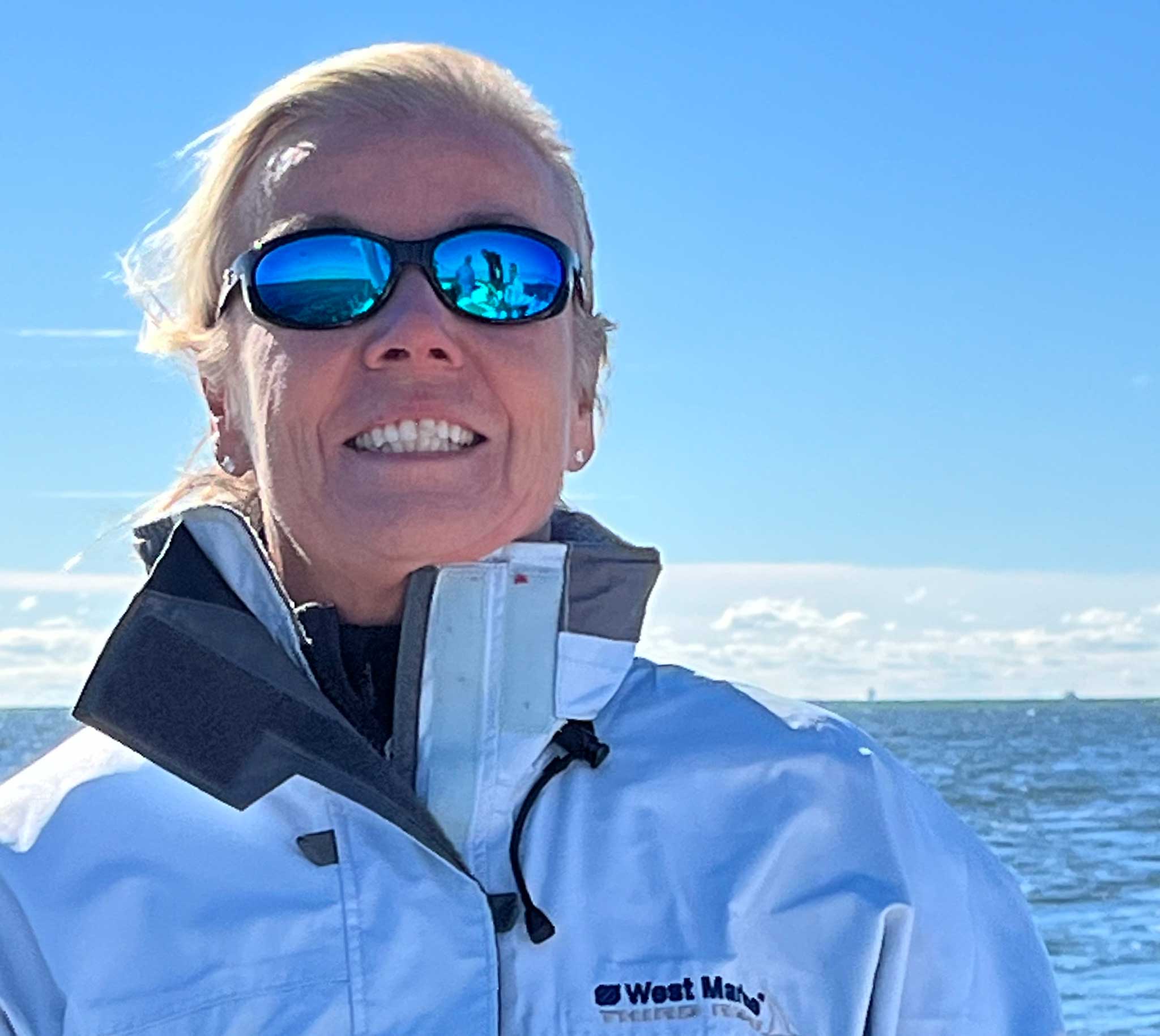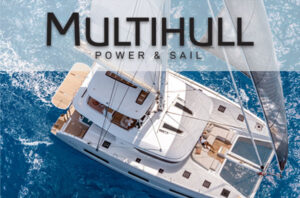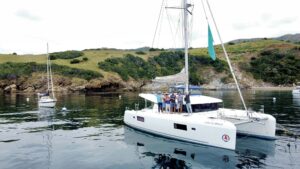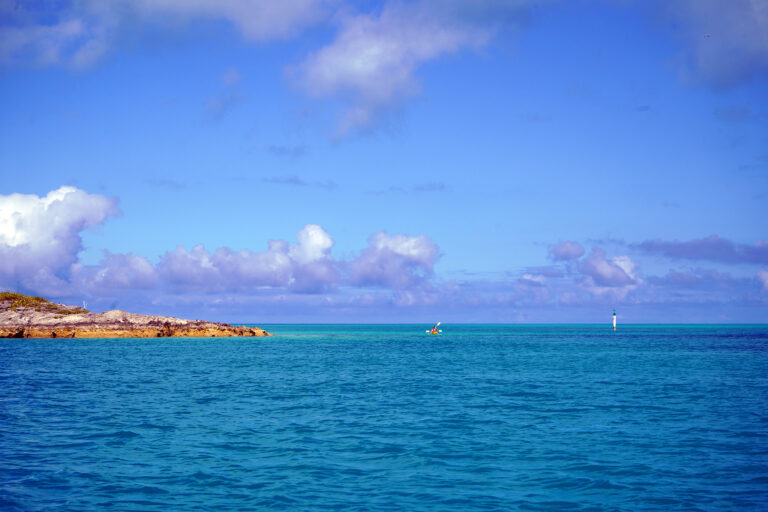For more multihull reviews and stories, subscribe for free to Multihull Power & Sail at sailmagazine.com/multihull

Since you’re reading this in a multihull magazine, chances are you’re already a fan of catamarans and are familiar with their advantages. They offer more room than same-length monohulls, they have system redundancy built in, they tend to produce less seasickness because they don’t heel much, and they can be faster since they’re not dragging a heavy keel through the water. At the same time, though, cats also offer a number of challenges that may have you rethinking how you manage a weeklong charter or an offshore passage. The lessons below (some hard won) are my personal tips on becoming Zen with two hulls and getting the best out of whatever multihull you may find yourself on.
The right direction
Unless you’re sailing a high-speed racing cat, chances are you won’t be seeing blistering speeds from a cat going to weather. Gunboats and HH catamarans can sail pretty close to the wind as can those built by Balance, Catana or any other catamaran with daggerboards. However, most cruising cats with small fixed keels have limited pointing ability.
Two shallow hulls don’t track like a single deep one, so forget about the concept of “beating.” Also, unless there’s a nice high bridgedeck, the pounding cats take in head seas can shake the kidneys right out of you. In 2017, on a delivery in the Caribbean from Guadeloupe to Grenada (a trip of about 400 miles if you’re taking the scenic route) I experienced a few days of this. It was only a week after Hurricane Maria (the predecessor to Hurricane Irma) and things were still pretty boisterous, with 30 knots of wind and 15-foot seas. Luckily, they were mostly on the beam. But when we missed our waypoint, we ended up having to go straight into the wind to make Martinique for the evening, an hours-long painful adventure during which each hit made the cat shudder.

Most days we lumbered over the big swells, first to port, then to starboard, and although it gave my abs a workout, at least it wasn’t bashing. The cat mostly stood upright, and we didn’t spend the week on our ear like we would have on a monohull.
There was one moment, though, when time stood still as we crested a particularly nasty wave. The port hull swung up and over, and the starboard hull reluctantly followed. Sitting alone on the flybridge, I saw the cat heel dramatically as we started to slide down the other side of the wave. It was a breathless few seconds as I wondered whether we’d trip over the port hull or right ourselves and slide into the trough. We slid and all was good.
On a charter, you can tweak the course to steer or change the itinerary completely rather than pound to weather. On a passage or delivery, however, there’s not much to be done other than perhaps slow down, although that doesn’t really lessen the slamming. If you’re very motivated, you can try hand steering rather than relying on the autopilot. In large swells steer more up the wave and the crest, then ease down the other side at an angle that won’t accelerate you too much and bury your bows.

Of course, hand steering on passage can be an ambitious undertaking, so it’s important to wait for a weather window or break up the trip into manageable legs to minimize fatigue and allow time to fix anything that breaks in heavy seas. If you can get where you’re going in protected waters, even if it makes for a slightly longer passage, take it. For example, if you can sail inside the St. Francis Drake channel on a British Virgin Islands charter, it may be better than taking a shorter but nastier route along the windward side of the archipelago.
A trick for pointing higher while saving fuel is to run the leeward engine alone and motorsail with the bows more into the wind. This will lessen the slamming, save fuel and still leverage the power of the wind. Lowering the leeward daggerboard (if you have one) also helps.
Like most boats, cats love a beam reach and many do well on a shallow broad reach as well. Downwind sailing is what cats are built for, and depending on their design and load, they can out sail a monohull most days of the week. Be warned, though, once you start sailing dead downwind, cats typically waddle in larger swells.
The cat shimmy

Speaking of swells, cats move differently from monohulls regardless of the point of sail, which is a motion that can be described as a sort of a short, herky-jerky boogie. At this point, I don’t even notice it anymore, but those new to catamarans may find it distracting.
In any kind of seaway, the square footage of deck space and the two hulls with all that beam make cats adjust to the waves in short, unexpected changes of direction. On a monohull in her groove, you can almost anticipate where she’ll go next, but on a cat, it’s anyone’s guess. For small kids just learning to walk and older sailors with tender joints, extra vigilance may be needed so a knee doesn’t get torqued. One hand for the boat at all times, even if the deck seems level for the moment.
Sail trim and reefing

Even cruising cats carry a lot of sail, with most of it typically in the mainsail. If you have an electric winch, use it. Grinding up the main on a 45-foot cat will make anyone sweat. That said, be careful as the main reaches the top of the mast. Electric winches are crazy powerful and will do damage if you accidentally leave your finger on the button too long.
On cats with a flybridge, you lose a lot of the sailplan down low because the boom is so high. Also, depending on the cat, it’s sometimes nearly impossible to reach the main even when standing on the hard bimini. This makes things tough for two reasons: 1) it can be hard to keep the full battens out of the lazyjacks as the sail is raised and 2) it can be hard to get the main down, especially if there’s friction in the lines as a result of them having been led at all sorts of strange angles to the helm. It can also be nearly impossible to tuck the sail and reefing lines into the sail bag. Loose canvas and lines get exciting when squalls blow through. What is usually a singlehanded job of raising or lowering the mainsail on a monohull can be a three-person job on a cat.
Large mainsails also mean lots of power, and in a blow that means lots of pressure on the systems. The crew needs to be extra careful when easing, sheeting in, or raising and dropping sail. Warn everyone to keep their hair, fingers, arms, and other body parts clear. The big sails aboard most cats can’t just be manhandled. In the Abacos, I had a main that only came down halfway in 30 knots of wind near an anchorage. It was no small undertaking getting it down without any of the crew getting hurt.
Knowing when to reef can be tricky on cats because you often don’t feel the boat being overpowered until it’s too late. I tend to leave the laundry up longer than I would on a monohull, which can make for some exciting sailing. Depending on the wind direction and sea state, you can be a little braver with reefing on a cat due to its inherent form stability, but keep an eye on it. I once kept all the canvas up in 28 knots of wind in the Exumas, and while we had a fierce and fun sail, we were very much on the ragged edge and it could have all ended in calamity had we suddenly found ourselves surrounded by, say, the region’s notorious coral heads.
Finally, sailing a cat skews normal sailing geometry. On most charter cats the headsail track is on the cabintop, which creates an air break when trying to flatten the sails on a close reach, as the sail bends in on itself when sheeted in. One trick that works (depending on the boat) is to take a spare line from the jib clue out to a cleat on the side deck to open up the slot, thereby creating a kind of barber hauler. The key is to remember to release it prior to tacking.
Practice, practice, practice
Beyond that, you can read theory all day long, but there’s no substitute for practice, not only to learn the basics, but also to figure out the nuances of a specific boat. Get to know your vessel—even if you only have it for a week. The best way to do that is to try out as many sailing and powering tips as possible so you can quickly become one with your kitty.
Cats under power

Sailing is fun, but powering is essential. Let’s face it, most people power more than they sail, so learning to drive a cat well will make you look like a rock star. Docking and close-quarters maneuvering are all about managing engine power, and cats enjoy the distinct advantage of having two propellers set far apart where the thrust makes them a snap to drive.
Under power, it’s easiest to leave the rudders centered (check your rudder angle indicator) not only because messing with the wheel adds complexity, but because at slow speeds catamarans don’t really need flow over the rudders to turn—the engines do all the work.
Use the wheel lock or your body to keep the wheel centered. Then, imagine holding a bar with both hands in front of you. Moving your right hand forward will move your left hand back. Notice how your shoulders turn and the direction you end up facing. Now apply this to the throttles. Powering forward with the starboard engine and aft with the engine to port will turn the cat to port and vice versa. You can also use only one engine in reverse for finer adjustments. Unless you’re in serious wind or current, it can even be better to use one engine at a time in order to not over correct. Easy does it for more precise positioning.
Because the props on cats are set far aft, the boats are actually more maneuverable in reverse than forward, since the sterns will be pulled in your desired direction faster than the bows will be pushed through the resulting wide arcing turn. Additionally, unless you’re on a flybridge model, you can see aft better than forward from bulkhead or hull helm stations, making docking in reverse safer still. You can also “walk” a cat sideways into a tight slip using the throttles. Because each boat will do this differently, you’ll need to experiment with how to best use the wheel and throttles to make this happen.
Most cats have mini-keels to help them track through the water. Others, like Catanas, Gunboats, and boats in the Balance and HH lines have daggerboards that can be retracted into the hull. Coming into a shallow anchorage, it’s hard to resist raising the boards all the way to avoid an accidental grounding. However, without at least some board/keel effect, the round hull bottoms will provide little grip, which in turn will impact steerage when, say, picking up a mooring or anchoring in windy conditions. I learned this the hard way one time coming into Bequia where we slid around like a bar of soap. Leaving a foot or so of the daggerboards down will provide enough traction to keep things under control.

Catamarans don’t coast like monohulls because they lack any kind of deep, heavy keel. As a result, relying on coasting to a dock at a shallow angle, then going into reverse and using prop walk to cozy up the stern doesn’t really work. Better to come in at a sharper angle and then pivot the boat into position with the engines, especially if things are on the tight side fore and aft. This works for leaving the dock, too. Use the outside engine to pivot around until either the bows or sterns are pointing out, and then use both engines to glide away.
Finally, when picking up a mooring, it’s better to have the crew stand on one bow rather than in the middle of the trampoline. First, the driver will lose sight of the mooring pretty quickly, making it harder to position the boat close enough for an easy pickup. Second, it’s safer for the crew to stand on a hard surface rather than potentially twisting an ankle in the soft trampoline. Pick up on the side you’re driving from and keep the ball in sight at all times. That way you’ll see what your crew is doing and whatever challenges they may face. Easy peasy!
SAIl Charter Editor Zuzana Prochazka holds a 100-ton master’s license, regularly leads charter trips around the world, and is a member of the SAIL Top 10 Best Boats review team. She serves as an international presenter on charter, safety, and technical topics, and is the executive director for the board of Boating Writers International.
For more multihull reviews and stories, subscribe for free to Multihull Power & Sail at sailmagazine.com/multihull
MHS Winter 2021-2022









